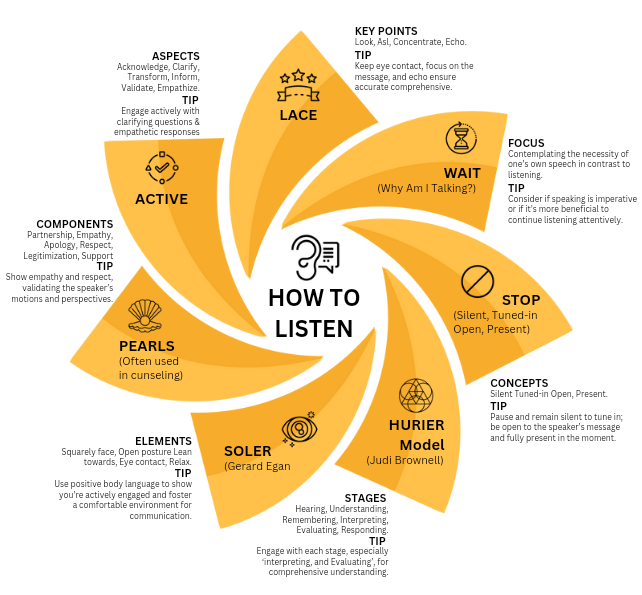Listening isn’t just about hearing words; it’s an art that includes getting the full picture, sharing in someone’s feelings, picking up on silent cues, and responding with care. Here are the best models to listen a pro—and making every conversation count.
HURIER Model (Judi Brownell)
Description: The HURIER model breaks down listening into six key stages: Hearing, Understanding, Remembering, Interpreting, Evaluating, and Responding. This comprehensive approach covers everything from the basic act of hearing to the more complex task of evaluating and responding to the information received.
Tip: Practice focusing on each stage, especially ‘Interpreting’ and ‘Evaluating’, to gain a deeper understanding of the conversation’s context and nuances.
SOLER (Gerard Egan)
Description: The SOLER model emphasizes non-verbal listening skills. By Squarely facing the speaker, adopting an Open posture, Leaning towards the speaker, maintaining Eye contact, and Relaxing, you demonstrate active engagement and create a conducive environment for effective communication.
Tip: Use these body language cues to show your attentiveness and create a comfortable setting for open dialogue.
PEARLS
Description: Primarily used in counseling, PEARLS focuses on Partnership², Empathy, Apology, Respect, Legitimization, and Support. This model encourages active engagement in the conversation by acknowledging and empathizing with the speaker’s experiences and feelings.
Tip: Be empathetic and respectful, ensuring that you acknowledge the validity of the speaker’s emotions and viewpoints
ACTIVE
Description: ACTIVE listening involves Acknowledging the speaker, Clarifying their points, Transforming the conversation into a constructive one, Informing or providing necessary information, Validating the speaker’s perspective, and Empathizing with their situation.
Tip: Use these steps to engage actively in conversations, encouraging a two-way flow of information and empathy.
LACE
Description: LACE stands for Look, Ask, Concentrate, Echo. This model encourages active engagement by maintaining eye contact, asking questions, concentrating on the message, and echoing to confirm understanding.
Tip: Echoing back what you’ve heard not only ensures you’ve understood correctly but also shows the speaker they have your full attention.
WAIT (Why Am I Talking?)
Description: The WAIT model is a self-reflective approach, encouraging you to question the necessity of your own speech in a conversation. It emphasizes the importance of listening over speaking and encourages a more thoughtful, measured approach to verbal contributions.
Tip: Regularly ask yourself “Why am I talking?” to ensure that your contributions are meaningful and enhance the conversation.
STOP (Silent, Tuned-in, Open, Present)
Description: This model is about pausing (Stop), remaining Silent, being Tuned In to the speaker, staying Open to the message, and being fully Present in the conversation. It emphasizes the importance of mindfulness and full engagement in listening.
Tip: Practice mindfulness in conversations by fully focusing on the speaker and the present moment, free from distractions or preconceptions.

